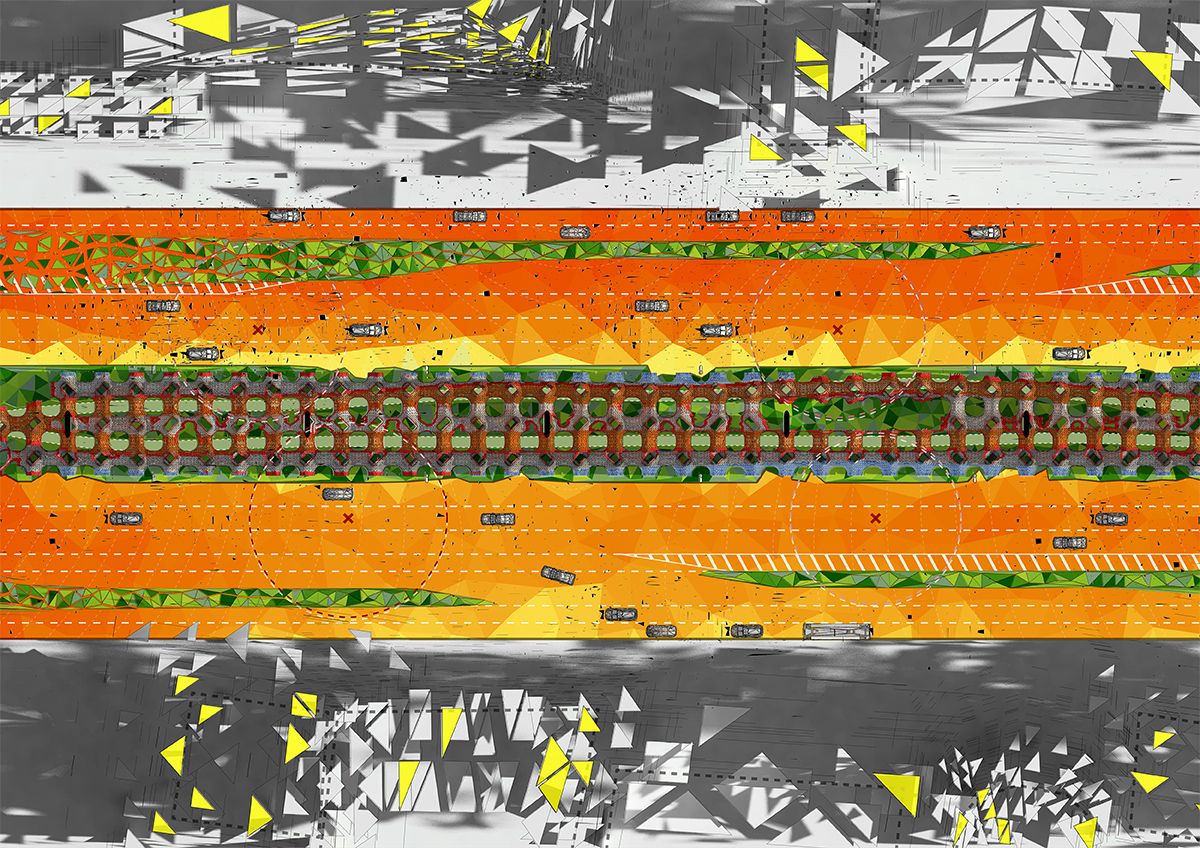Prasiolite State - Part 3 - Green Crystals of Bangkok
- Chokoon

- Jun 15, 2019
- 4 min read
Updated: May 21
Prasiolite State is a semi-modular outdoor architectural installation nestled beneath the Skytrain tracks between Krung Thonburi and Wongwian Yai stations. The structure features vegetation-bearing shell forms that respond dynamically to the array of environmental forces characterizing the site. These forces include carbon monoxide emissions from vehicular traffic, ambient noise pollution, heat radiation, temperature fluctuations, humidity levels, and wind intensity; each influencing the design’s functional and ecological performance.

These environmental factors directly influence the formation and development of the architectural construction. The parametric design of the enclosure is engineered to respond dynamically to multiple forces, resulting in a spatial configuration that is both contextually sensitive and optimized for its specific site conditions.
The structure will be able to perform better and better through time as nature gradually overtakes architecture and undergoes the Prasiolite State.

Our depicted site is a narrow strip of vacant land located within one of Bangkok’s urban bottlenecks. This undeveloped green space lies beneath the Skytrain tracks between Krung Thonburi and Wongwian Yai stations, wedged between two busy, oppositely directed roadways. Its elongated form presents unique challenges and opportunities for architectural intervention in a densely trafficked urban context.
The design proposes an array of modular polygonal units strategically arranged to fill the space between the two train stations. Rather than uniform repetition, these linear sequences of modules dynamically respond to site-specific environmental force data. By integrating sensor readings with a predefined set of design rules, the programmatic functions and overall form of the structure are adaptively shaped to optimize performance and spatial experience.
(Slide to Preview)
Site Plan - The polygons are packed tightly along the narrow site under the Skytrain track. These polygons will react to the converging data respective to the region they occupy.
The fabrication technique employed is based on skin-like, thin-shell construction. The installation’s surface is composed of uniquely shaped triangular panels, precisely connected through custom-designed joints.
This approach enables the structure to assume a variety of complex environmental and spatial configurations, facilitating an infinite number of topologically distinct pathways between any two points within the installation.
(Slide to Preview)
Custom connections and joints

The combination forms into a functional space
The construction features a fully parametric, perforated skin meticulously designed in harmony with the natural environment. The surface acts as a living scaffold, enabling vegetation to anchor and integrate seamlessly with the structure. The intensity of environmental forces and local gas concentrations inform the variation in skin permeability and directly influence the spatial organization and programmatic distribution within the installation.
The inspiration is obtained from features in botany called the "Stomata". They are pores, tiny openings found in the epidermis of leaves and plant tissue that allow for gas exchange.


As time progresses, nature will gradually reclaim the perforations in the skin, enhancing the structure’s ability to absorb and reflect ambient noise while filtering pollutants such as carbon monoxide, carbon dioxide, particulate matter, and other undesirable gases.
The program is designed to activate the expansive space beneath the Skytrain tracks as a vibrant public space, inviting locals to exercise, relax, and engage with the community. Functioning as a recreational park, the spatial programs are thoughtfully placed to maximize usability and respond optimally to the specific conditions of each area within the site.
Programs positioning in sequential with space hierarchy
Resting Zone - Small, low-impact pavilion units are protected in the core of the site, providing a sheltered environment with minimal exposure to enhance privacy and tranquility.
Situated in: Low Gas - Low Noise regions
Children Zone - Play areas designed with height restrictions, confined to ground level to ensure safety and accessibility for younger users.
Situated in: Lowest Gas - Lowest Noise regions
Adult Zone - Playgrounds featuring vertical elements that encourage a wide range of physical activities and movement.
Situated in: Medium Gas - Medium Noise regions
Performance Zone - The most vegetated open space, designed as a flexible, multi-purpose area for community events and performances.
Situated in: High Gas - High Noise - High sunlight radiation regions
Bus Zone - Primary public transportation access points that connect to the main roads.
Situated in: Highest Gas - Highest Noise regions
Heat and ventilation value create a continuous setback for the architecture
The architecture functions like a living organism, its form composed of a diverse assemblage of materials. Its physique comprises of aluminum, stainless steel, acrylic, steel mesh, timber, leather, and bioluminescent panels; each contributing distinct textures and functional qualities to the overall composition.

Each material component plays a critical role in the construction and performance of the structure. Aluminum and stainless steel provide structural stability and resilience. Timber serves as an insulating layer within the cavities, offering both tactile warmth and emotional resonance. Acrylic panels allow natural light to penetrate specific areas, enhancing interior luminosity. Leather-covered panels soften hard edges, creating a more comfortable and approachable tactile experience. Bioluminescent panels absorb solar energy during the day and emit a gentle glow at night, enhancing visibility and atmosphere during nocturnal hours.
Every element in the architectural body is purposefully positioned, with its function and material qualities carefully aligned to its location, collectively generating a cohesive, optimized design experience.
Plan - The drawing shows a zoom-in portion of the space to emphasize the array of surface induction.
Axonometric - Captures the spatial relationship between the architecture and its context
Atmospheric Experiences

The section displays the flow of intensive forces and the motion of the structure when being implemented into the context
(Slide to Preview)
Mega Section - Architecture nestles under the Skytrain track between Krung Thonburi and Wongwian Yai station

Exploded Assembly - Fabrication parts, materials, components, and miscellaneous required in the construction of a single module.
The objective of Prasiolite State has been realized through a rigorous exploration of computational design methodologies. The project embraces innovation in both design and construction by capturing environmental sensor data, employing computer-aided design techniques, and utilizing digital fabrication for precise, efficient production. This integrated approach contributes to reduced costs, minimized labor demands, and optimized material usage while simultaneously enhancing design performance.
Finally, the project seeks to push the boundaries of architectural practice by delivering solutions that are both aesthetically compelling and functionally responsive. Prasiolite State stands as a vibrant prototype for fresh, organic, and intelligent design systems, marking a progressive challenge in the evolution of contemporary architecture today.
Credits:
Supervision by Patrick Donbeck
The project was published on Designboom:
Read Part 1:
Read Part 2:




























































































































Comments